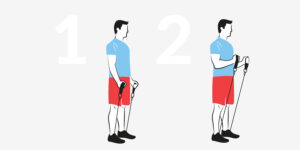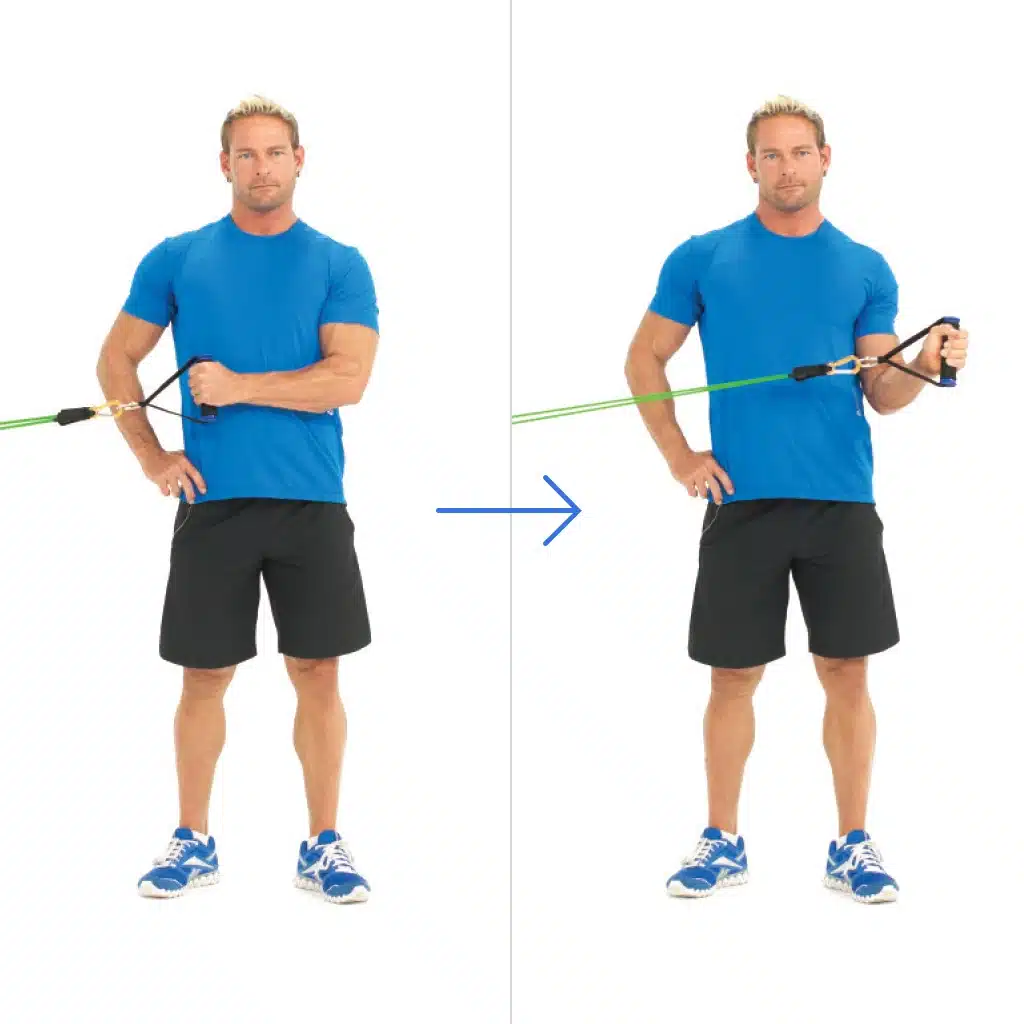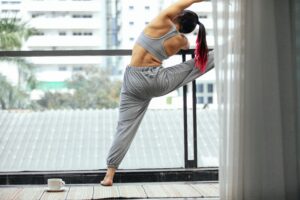Table of Contents
The Power of Resistance Band Shoulder Workouts
The shoulders frequently stand out as a distinguishing sign of upper-body power in the pursuit of physical fitness and strength. In addition to helping you look nice, strong shoulder muscles are essential for preserving functional mobility, encouraging proper posture, and lowering your chance of injury. Resistance band shoulder exercises are becoming more and more well-liked as the value of shoulder strength and appearance is acknowledged.
A crucial portion of the upper body are the shoulders, which are made up of the anterior (front), lateral (side), and posterior (rear) deltoid muscles. They support a wide variety of actions, including reaching across the body and lifting objects aloft, emphasizing their importance in daily tasks and athletic performance. The shoulder joint is extremely prone to instability and injury, particularly when the supporting musculature is weak or unbalanced, thus this incredible mobility does come with a warning.
Exercises with resistance bands for the shoulders have become an innovative fitness trend, providing a dynamic method for building robust, well-defined shoulders. These exercises make use of the adaptable power of resistance bands and offer many benefits to novices, fitness lovers, and seasoned athletes alike. In this thorough book, we’ll examine the fundamental value of strong shoulders, delve into the countless advantages of resistance band training, and set off on a journey via efficient exercises and methods that will enable you to utilize your shoulder muscles to their fullest capacity.

The Significance of Strong Shoulders
Additionally, having strong shoulders is very important for good posture and spinal health. The significance of having good posture cannot be emphasized in the modern digital age where hours are spent hunched over screens. Strong, balanced shoulder muscles are essential for maintaining a straight, proud upper back. They address the postural issues caused by prolonged sitting, lowering the danger of developing rounded shoulders or a hunched upper back—a condition that is becoming more prevalent in our contemporary, technologically-driven lives.
Strong shoulders are the cornerstone of performance excellence in the world of sports and athletics. Shoulder strength is essential for generating power, maintaining stability, and preventing injuries in sports as diverse as weightlifting, tennis, basketball, and swimming. The strength of shoulder muscles is necessary for a strong serve in tennis, a perfect stroke in swimming, or a great slam dunk in basketball. Effective shoulder training promotes longevity and success in sports by improving athletic performance while also greatly reducing the risk of common shoulder injuries.

The Unique Power of Resistance Band Shoulder Workouts
Exercises for the shoulders that use resistance bands are specifically designed to take use of these advantages, utilizing the bands’ adaptability and diversity to efficiently target the anterior, lateral, and posterior deltoids. These exercises cover a wide spectrum in order to provide you a thorough shoulder training experience.
This article will go into detail about specific resistance band shoulder workouts that each focus on a different part of the shoulder complex. These workouts will increase your shoulders’ strength, stability, and functionality in addition to their appearance. You will embark on a transforming path toward stronger, more contoured, and durable shoulders by including resistance band shoulder workouts into your training regimen.
In conclusion, the strength of resistance band shoulder exercises resides in their capacity to strengthen and change the shoulders, enhancing functional mobility, correct posture, and injury prevention. You will learn the enormous potential for developing strong and shaped shoulders with the adaptable power of resistance bands as we delve into the exercises and methods that make up this dynamic workout regimen.
Front Raises:
- Stand on the resistance band with your feet shoulder-width apart.
- Hold the band between your thighs with both hands, palms down.
- Straighten your arms in front of you, raise them to shoulder height, and then bring them back down.
This workout concentrates on the front deltoids.

Lateral Raises:
- Place your feet at shoulder-width apart while you stand on the resistance band.
- With your palms facing your body, hold the band with both hands at your sides.
- Reach shoulder height with your arms straight out to the sides, then bring them back down.
- The side deltoids are the focus of this workout.

Bent-Over Reverse Flies:
- Place your feet at shoulder-width apart while you stand on the resistance band.
- Hold the band between your thighs with both hands, palms facing one another.
- Get into a small forward lean by bending at the hips and knees.
- Squeezing your shoulder blades together as you raise your arms out to the sides.
- The upper back and rear deltoids are the targets of this exercise.

- Place your feet hip-width apart and stand on the resistance band.
- With both hands and the palms facing front, hold the band at shoulder height.
- Once your arms are completely extended, press the band above and then bring it back down to shoulder level.
- All three deltoid heads are worked in this exercise.

- The resistance band should be fastened to a strong position at chest level.
- Holding one end of the band in each hand, stand facing the anchor point.
- Retract your steps to make the band more tense.
- Retract your shoulder blades as you pull the band toward your face.
- The upper traps and rear deltoids are the focus of this exercise.

External Rotations:
- At waist height, fasten the resistance band to a doorknob or a reliable anchor.
- Holding the band in one hand, slant toward the anchor point.
- Keep your elbow bent at a 90-degree angle and near to your side.
- Return to the beginning position after rotating your forearm outward against the band’s resistance.
- The rotator cuff muscles, which assist shoulder stability, are strengthened by this exercise.

Remember to use proper technique and start with a lighter resistance band to prevent overusing your shoulder muscles. Gradually raise the resistance as you gain strength. Furthermore, if you experience any pain or discomfort while executing these exercises, stop immediately and seek the counsel of a doctor or fitness expert.In conclusion, a resistance band shoulder workout offers a practical and efficient path to developing strong and well-defined shoulder muscles. Understanding the importance of shoulder strength for both functional fitness and aesthetics is the first step toward achieving your fitness goals. The shoulders, with their incredible mobility, are involved in numerous daily activities, making their strength a critical component of overall well-being. Furthermore, strong shoulder muscles contribute to better posture, injury prevention, enhanced athletic performance, and the ability to perform various upper body movements with ease.
Resistance bands are the perfect instrument for targeting the anterior, lateral, and posterior deltoids because to their distinct qualities. Individuals of different fitness levels, from novices to advanced athletes, can use them thanks to their portability, adjustability, and versatility. By offering a safe and controlled kind of resistance, resistance bands lower the risk of injuries brought on by quick or jerky motions. Resistance bands are an affordable and practical method for increasing shoulder strength and endurance thanks to the variety of exercises and variations they can be used for.
To maximize the benefits of your resistance band shoulder workout, it’s essential to maintain proper form and incorporate these exercises into a balanced fitness routine. A well-rounded approach includes not only strength training but also proper nutrition, rest, stretching, and hydration. Adequate protein intake supports muscle repair and growth, while rest and recovery are crucial for muscle development. Regular stretching and mobility exercises help maintain shoulder flexibility, reducing the risk of muscle tightness and discomfort. Foam rolling can further alleviate muscle tension in the shoulder and upper back.
It’s crucial to pay attention to your body. It’s crucial to stop working out if you feel pain or discomfort that doesn’t go away and get advice from a doctor or a trained fitness professional. Your wellbeing and safety should always come first.
Resistance band shoulder workouts can improve upper body function, your general quality of life, and your physical appearance in addition to your physique. Spending time on shoulder training is a wise investment in your fitness journey, whether your goals are to better daily activities, lower your risk of shoulder problems, or increase athletic performance. So take advantage of the chance to grow your shoulder muscles, enhance your posture, and reap the many advantages that come with them.
“Your uniqueness shines through every inch of your skin”




